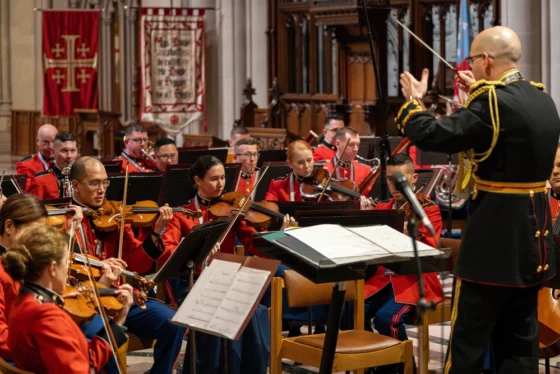U.S.S. Ford: Mighty ship named for a modest man
Navy gives reporters a tour of latest carrier, still in a long tune-up stage for deployment.
ABOARD THE U.S.S. GERALD R. FORD — To the casual eye, the ship is a thing of unrelieved ugliness. Not a square inch of floors, ceilings or walls have so much as a shred of decoration or design other than that of pure utility.
Yet it adds up to a thing of beauty, a factory backdrop to a carefully choreographed ballet of human activity aimed at turning a 1,092-foot, 100,000 ton vessel into an effective warship. It’s not quite there yet; the Ford — the first of a planned four Ford-class carriers — is still in what the Navy calls post-delivery test and trials. It was delivered by the contractor in 2017, commissioned later that year. But unlike a new airliner or front-end-loader, a warship gets delivered fairly raw. Besides testing and trying, the Navy is also tweaking tens of thousands of details to ensure that the ship and its crews operate reliably should the call come.
Carrier takeoffs and landings — the Navy calls returning planes “recoveries” — seem routine. And they are, in the same sense that Vladimir Horowitz playing a Liszt sonata is routine. You don’t witness the thousands of man-hours of rehearsal that lead to two seconds of thunder before the catapult lets go. My thought on watching the F/A-18s return to deck was a shudder. “How in the heck do these young crew members survive the first time trying this?”
I did see and hear carrier operations up close Tuesday, when participating on a Navy “embark.” Skilled at public affairs, the Navy regularly takes small groups of scribblers and TV people to ships. Because of staff logistics here, I ended up as the Federal News Network representative.
Basically still a kid at heart who loves airplanes and big machines of any sort, I leapt at the chance. The Navy was to fly us from its base in Norfolk, Virginia out to the Ford, about 70 miles away in a training zone patch of ocean off North Carolina. Fly to and from an aircraft carrier using the tail hook and catapult? I thought, “Hell yeah, I’m in.” I realized how safe this would actually be when, in the waiting room by the tarmac, we were joined for the trip by Rear Adm. John Meier, commander of Naval Air Force Atlantic. It would be his young charges flying us out.
Amid tours of many of the essential elements of the gigantic ship, a couple of messages emerged from the Ford’s leadership. One is that it’s on schedule for eventual acceptance into the fleet for deployment with live ammunition. The tests now underway use dummy loads. Second is that design changes from the current class of carrier, the Nimitz class, make the Ford and its eventual sister ships more efficient and agile in combat.
Carriers have certain elements that enable them to be floating air bases. The Ford famously has an electro-magnetic catapult that replaces the steam mechanism of earlier carriers. Both throw the planes into takeoff speed, but the new version requires less apparatus below, freeing up space. Carriers have elevators to move bombs and missiles up from the magazines to the flight deck. Ford has electric, rather than hydraulic ones. That means less maintenance. The layout is all different from the Nimitz carriers, so a given mission load can be staged just below the flight deck and quickly slid into place.
The cabalistic details are endless, and fascinating to military tech and operations buffs, including me. But the effect of all these refinements is the big story: more efficient and agile combat operations, according to Rear Adm. Craig Clapperton, commander of Carrier Strike Group 12. For pilots, flying from and to a Ford class carrier will be identical to that of a Nimitz. All of the process refinements will occur below the flight deck.
It hasn’t been an easy path. The catapult failed for a couple of days in tests just a few months ago. The elevators required months and months of fine tuning, requiring tolerances in the tiniest fractions of inches to work smoothly. Not all of the 11 elevators are yet certified. The commanders said that they’re finding long lists of needed improvements in the carrier that they’re constantly feeding back to the contractors, now building the next Ford-class carrier.
Beyond that, the $13 billion craft is years late and has had all sorts of problems since the keel was laid in 2009. But the project, the Navy officials say, is jelling.
Naively, I expected to see something new and spiffy. I once was on an airline flight with only a few other passengers. The plane looked and smelled extraordinarily fresh. The pilot told us we were on the very first revenue run of an MD-11. By contrast, if someone told me the Ford had been underway for 25 years, I’d have believed it, from the look of the interior. But with thousands of sailors traipsing the halls 24 hours a day, doing their myriad jobs, the ship looked … lived in.
But by my visit, Clapperton and Ford commander Captain J.J. Cummings reported that the testing had moved to what they termed “cyclic” operations — air sorties at a pace that would be expected in combat. They said the ship is now capable of launching four planes in less than two minutes. Now the Navy is working for a 2022 deployment with live weapons.
Interesting as the abstract discussions of specifications might be, close up the whole thing is a stunning array of industrial activity, all culminating in the essentials of the air wing operations. Why, the maintenance and staging bay below the flight deck is an open space the size of a shopping mall.
I’d never seen a fighter take off from just a few paces away. The journalists, just like everyone else on deck, were required to wear “cranials,” two-piece head protectors with sound-tight ear covers.
The backstop raised, the catapult is clipped into the plane’s nose gear by a sailor stooping underneath. Several other flight deck crew members attend to details at a pop-up workstation on the edge of the deck. All at once everyone stands and points in the same direction. The pilot revs the quivering plane to military power, what in civil aviation they call takeoff power. On an unseen cue, the catapult yanks the plane down the runway like a dog track chase rabbit. The sound might be muffled by the cranial, but I got a distinct sense of the intensity because the very cartilage in my nose vibrated along with the feel of a shock wave on my torso, clad over my clothes in a heavy white canvas flight deck vest.
It didn’t just impress me. At one departure, Capt. Cummings slapped me on the back and whooped, “I never get tired of that sound!”
Watching several F/A-18 takeoffs together with launches of turboprop surveillance and communications planes, the thought also struck me: Only a rich nation can assemble and sustain this amount of cost and power, much less a whole fleet of them. Clapperton commented at lunch that an annual carrier operating budget is north of a half billion dollars. That’s nearly $1.4 million a day.
For that lunch of iced tea, hors d’oeuvres, cookies, and fruit, public affairs said they’d be collecting $5.65 from each of us, but they never did. So the nation spent $1,400,062.15 Tuesday for the Ford. During our galley tour, where the Ford’s 18,000 meals per day are prepared, I stopped briefly to watch a culinary specialist — don’t call them cooks — basting some tremendous-looking barbecued ribs. Rear Adm. Clapperton and I joked we’d been hoping they’d put those out for the press lunch.
I did err in saying the Ford totally lacks decoration. Capt. Cummings’s office has a huge wood desk, sofas and a long dining table, and paneled walls. It’s decorated with many items of President Ford himself — family pictures, favorite books, furniture from his presidential days, the flag that draped his coffin. It was good to recall this essentially decent man. I recall that President Ford made his own toast on the day he accidentally ascended to the presidency, before moving into the White House.
My one regret was not seeing the ship from a distance. The ancient C-2 Greyhound plane on which we were ferried to and from the Ford, seats facing aft, lacked any sort of creature comfort, including windows. But stepping out onto the wind-whipped deck under a cloudless sky — that was an eye-opening, momentarily surreal experience.
Tomorrow, part two: the people of the U.S.S. Gerald R. Ford
Copyright © 2025 Federal News Network. All rights reserved. This website is not intended for users located within the European Economic Area.
Tom Temin is host of the Federal Drive and has been providing insight on federal technology and management issues for more than 30 years.
Follow @tteminWFED








